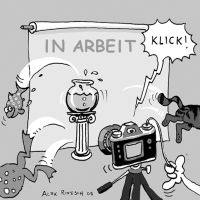Fat Sand Rat (Psammomys obesus)
| Fat Sand Rat Psammomys obesus | |
|---|---|
| Name | Fat Sand Rat |
| Name Lat. | Psammomys obesus |
| Family | Murids |
| Family lat. | Muridae |
| Order | Rodents |
| Order lat. | Rodentia |
| Origin | North Africa |
| Climate | Subtropical |
| Habitat | Semi-desert, steppe |
| Diet | Seeds, green fodder, insects |
| Behavior | Diurnal, nocturnal |
| Keeping | Pair, group |
| Care Level | Moderate |
| Life Span | 3-5 years |
| Protection | No |
| Metric Units | |
| Size | 13-20 cm |
| Temperature | Room temperature |
| Housing | A: 0.75 m² / H: 0.7 m |
| US Units | |
| Size | 5.1"-7.9" |
| Temperature | Room temperature |
| Housing | 8 ft² / 25" hight |
Distribution and habitat
The wide range of the diurnal and nocturnal fat sand rats extends from northwest Africa to the Arabian Peninsula. There they live in the barren, rocky, succulent-covered deserts and semi-deserts, where they make extensive underground burrows.
Maintenance
Minimum dimensions for the enclosure:
| 1-2 animals | area: 0,75 m² | height: 0,7 m |
| Each additional animal | Area: + 20 |
An enclosure that is placed in a bright (no direct sunlight), draft-free and quiet place is recommended, with ventilation openings at the sides, and it must not be tightly closed at the top. The enclosure should be diversely structured with stones, roots and branches, and provide hiding and shelter opportunities (rodent houses, tubes, clay caves, etc.). They need food and drinking containers (drinking bottles), a sand bath (chinchilla sand) for grooming, nesting material (hay, straw, etc.) and a sufficiently deep substrate for digging. Commercially available small animal litter or a sand-soil mixture covered with some bark mulch and dry leaves is suitable as a substrate. Nail material, such as untreated twigs and branches from fruit trees, as well as a rodent stone, must always be available to wear down their teeth. They should be kept at room temperature and their natural day-night rhythm should be respected.
Diet
In the wild, they live almost exclusively on succulents such as the shrubby pennywort (Atriplex halimus). The food supply consists of a mixture of low-fat seeds, available in specialized shops as "gerbil food", forage hay and Chinese cabbage, supplemented with some chinchilla pellets and fresh food, such as cucumber, zucchini, endive lettuce and fresh spinach. In addition, they need some animal protein, such as insects (grasshoppers, house crickets, mealybug larvae) or insect food for hedgehogs. Vegetables can be salted once a week with a little table salt or baking soda, although the need to add salt for acclimated animals is debatable. Sugary fruits and vegetables (e.g. carrots) should not be fed (risk of diabetes). Drinking water must always be available in hanging bottles or in stable, open containers and, like food, must be offered fresh daily
A varied diet promotes health and prevents deficiency symptoms.
Behaviour and compatibility
In nature they live in loose colonies with fixed territories. They should be kept in pairs or in a harem, 1 male with 2-4 females. Females in particular can be very territorial and aggressive during the rearing of young. At the first sign of incompatibility, separate the animals immediately
Reproduction and breeding
In the male, the anal and genital openings are farther apart than in the female.
The gestation period is about 25-30 days. The average 2-7 young are born naked, blind and deaf, are independent after 4 weeks and should remain with the mother for a few days afterwards. The life expectancy is 3-5 years. After about 3 months they are sexually mature.
Important
Their high kidney activity allows them to eat highly saline plants and thus survive in high heat and drought. It is especially important to offer sufficient salt to wild-caught animals in the first 2-3 months to meet their salt requirements. The fat sand rat is prone to diabetes and obesity when fed a high energy diet.
They are very agile, running quadrupedally and fleeing kangaroo-like hopping on their hind legs when in danger. Running wheels must be injury-proof, have a closed running surface and back wall, with a diameter that allows the animals to run without bending their backs. As escape animals, they need sufficient retreat and hiding places, so the enclosure should also be somewhat elevated and not placed on the floor.
They should not be grabbed or pulled by the tail, as the skin can easily crack and detach. The animals should only be grasped by hand from below and lifted up. Particular attention should be paid to thorough hygiene and contamination should be removed regularly.
Further literature can be found in your pet store.
References
Text: petdata; Image: Alex Rinesch
Source: W. PUSCHMANN, D. ZSCHEILE, K. ZSCHEILE (2009): Zootierhaltung - Tiere in menschlicher Obhut: Säugetiere, Harri Deutsch Verlag EHRLICH (2006): Kleinsäuger im Terrarium, Natur und Tierverlag; BMEL (2014): Gutachten über Mindestanforderungen an die Haltung von Säugetieren
- Gemäß § 21 Abs. 5 Tierschutzgesetz idgF
